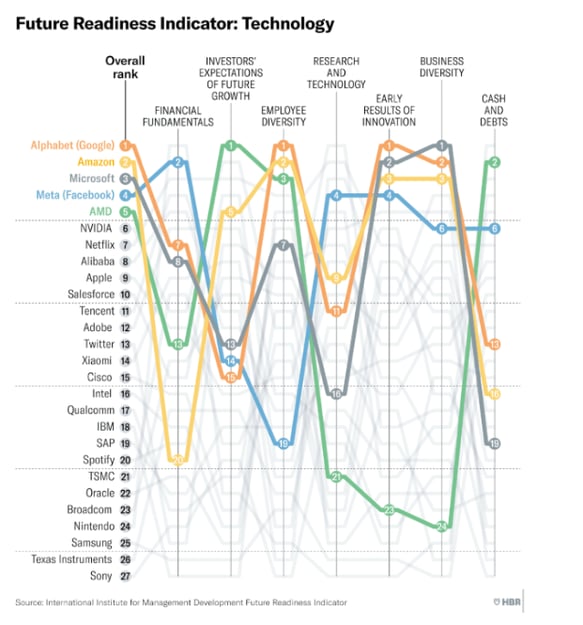In our monthly innovation updates, we provide you with an overview of the most relevant insights, best practices & tools from the innovation cosmos.
Topics in March
1. How Data Can Hinder Your Innovation Efforts
Let's get one thing straight right away: data can be a powerful driver for innovation - if utilized properly. An organization needs data to make informed decisions about where to focus its innovation efforts. If you collect data in the right way, it can provide valuable insights on which you can act.
However, not all data is beneficial to your organization. Many teams waste resources by jumping from idea to idea without really analyzing where it is most impactful to innovate. Others get stuck in the data collection stage because they are too busy gathering data without making sense of it. An article in IM Weekly highlights five data missteps that paralyze innovation:
- An inadequate amount of data
To ensure that your interpretation of innovation needs is accurate and not just based on assumptions, you need both a multitude and high veracity of data. It requires collecting as much data as possible from multiple sources and making it accessible to your team.
- The wrong data for your problem
In order to have the correct data to justify innovation, define for what specific context or problem you need to collect information.
- Inaccurately measured data
To ensure that you identify the right metrics and measure data accurately, you need reliable and consistent processes. Defining the metrics relevant to your question or problem is critical.
- Failure to analyze your data
A lack of data is usually not the problem companies face, but rather a lack of analysis and understanding of the large amounts of data. You need to be able to get insights from your data to make informed decisions.
- Reacting too quickly to data
Companies tend to innovate based on what their competition is doing. However, before developing a new product, you need to understand why others have innovated in a certain direction (is it a trend or an emerging technology with great potential?). Or even better, instead of following others, innovate on an existing product or process that allows you to address changes or needs on the market.
For a strong innovation strategy, your organization should understand how its current world affects its future world and how its future world can be shaped by the data it already has. Providing you and your team with the right information at the right time for the right reasons enables quick and accurate responses that drive competitive advantage and future growth.
Also see this article: Data-Driven Innovation For Informed Decision-Making
Download: Your Tool to Move Data to Insights
Don’t make data a hindrance to your innovation! With ITONICS Insights you can scan millions of verified sources in real-time to spot drivers of change, new trends, emerging technologies, startups, and other early signals.
2. Five Misconceptions in Innovation Management You Should Ignore
Being innovative also means being critical - of your organization's status quo but also of preconceived notions in order to find new ways to move forward. A recently published FORBES article discusses five common misconceptions in innovation management, some of which you may already be familiar with:
- New product development prototypes are cost-prohibitive.
Have you ever heard of a minimum viable product? You don't need a perfectly working prototype to present your solution and collect first feedback. It often can be simple and just show enough features to demonstrate how the product will solve a problem. This is an agile approach to product development and avoids investing a lot of effort.
- Innovation is centered on great ideas.
Innovation doesn’t start with ideas; it starts with information. Before ideating new products or services, you first need to understand your customers' problems or demands on the market. Once you have identified ideas with high future potential, you also need a plan to bring them to life that aligns strategy to execution.
- Innovation will define a company’s culture.
Rather the opposite. Your company’s mission actually determines your innovation strategy. Before you develop new products or services, you need to know why you are developing them and make sure they contribute to your company's stated purpose.
- Innovation processes and methodologies are fads.
It is important to consider that each business, including its mission and customers, is different. Rather than simply following new approaches such as Agile, Lean, or Stage-Gate Innovation, evaluate which method makes the most sense for your organization and adapt methodologies to your specific needs.
- All research is good research.
To determine where to focus innovation efforts, organizations have to invest in research. However, for many companies, the investments do not produce results they can commercialize. Research should enable companies to gain insights from data on how to solve customer problems or leverage trends and technologies.
Keep in mind that widely held beliefs may have been true once, but you should constantly question them.
3. Our Trend of the Month: Green Skills Gap
One of the objectives of the Decade of Action is the prioritization of green skills across industries to better align environmentally-conscious practices and organizational objectives.
Green Skills are the key capabilities required to create a sustainable and resource-efficient society. The push to develop green management skills calls for the upskilling of professionals across industries and educational systems to prioritize environmental sustainability as a key learning outcome, regardless of career path.
According to LinkedIn's Global Green Skills Report, in 2021, less than 1% of hiring pertained to green jobs, and half excluded green skills entirely. However, a strategic and vital shift is underway as governments, corporates, and civil society increasingly prioritize green skills to support sustainability and combat climate change. This means that at the current rate of change, demand for green jobs will outpace the supply of people with the relevant skills in the next five years.
in 2021, less than 1% of hiring pertained to green jobs, and half excluded green skills entirely. However, a strategic and vital shift is underway as governments, corporates, and civil society increasingly prioritize green skills to support sustainability and combat climate change. This means that at the current rate of change, demand for green jobs will outpace the supply of people with the relevant skills in the next five years.
Fortunately, there is progress in growing green skills and emphasis on sectors like sustainable fashion, fleet management, and sales. Indeed, LinkedIn found that most jobs that call for green skills are not “traditional” green jobs but are roles intended to help sectors make the green transition.
To help fill this gap, curricula, from early education to corporate training, must adopt an interdisciplinary approach to make sustainability a core competency. Educational institutions, governments, and communities will need to collaborate and think creatively, forming partnerships with businesses to develop the green skills capacity of the global workforce.
The National University of Singapore is one institution that is pioneering the skills it views as essential in achieving net-zero emission pledges and global food security in the future. It has launched a new course module dedicated to meat alternatives. The module aims to set young food scientists on the path toward plant-based and cultivated meat R&D.
Carbon Co-op is a UK-based grassroots organization that provides building contractors with accessible and practical training on increasing home energy efficiency. It also helps connect contractors with potential customers and projects to transfer their new skills into real-world work opportunities.
Beyond having the right skills and qualifications, it is increasingly important for an organization’s values and practices to be transparent and resonate with its stakeholders—employees included. Citizen Kind is an ethical recruitment consultancy that is working to address this. It matches eco-conscious candidates with purpose-driven organizations.
To explore more sustainability trends, check out the ITONICS Sustainability Trend Radar containing 30 demand drivers most relevant to the UN 2030 Agenda for Sustainable Development.
4. Fact of the Month: Future-Readiness of Top Tech Companies
A recent Harvard Business Review article highlights the most “future-ready” companies across four sectors, based on research by the IMD (International Institute for Management Development).
One of these sectors is technology. The technology sector is moving at high velocity, and executives need to be able to pivot quickly to avoid being left behind. Technology companies are characterized by flexible organizational structures that enable them to adapt rapidly to a changing business environment. The five top players in the industry Google, Amazon, Microsoft, Facebook, and semiconductor manufacturer AMD, exhibit, despite their size, a strong entrepreneurial outlook. They are willing to move away from their core business and possess the ability to scale quickly. This flexibility helps them stay ahead in a sector that is constantly changing.

Read on here if you want to learn more about the scores and the factors on which the companies were evaluated.
5. Your Monthly Dose of Innovation
The Innovation Roundtable Summit is back!
The IRS is the world's largest gathering of business innovators - and we will be there.
Meet us from May 10 - 12, 2022 in Copenhagen and
- connect with 600 innovation executives from 250 multinational companies.
- learn from corporate & academic speakers.
- share your challenges and gain new ideas at
peer-to-peer roundtables and Labs.






